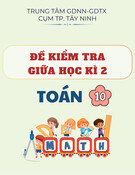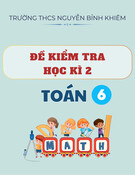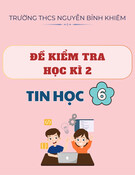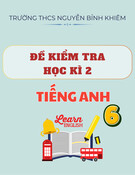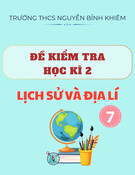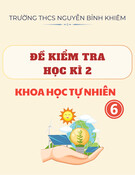
S GD& ĐT B C NINHỞ Ắ
Tr ng THPT Hàn Thuyênườ
(Đ g m 5 trang)ể ồ
Đ THIỀ
TH THPTỬ
H và tên thí sinh:.....................................................................ọ
S báo danh :.....................................................................ốMã đ thi 347ề
(ID: 210770 )Mark the letter A, B, C, or D on your answer sheet to indicate the
word(s) CLOSEST in meaning to the underlined word(s) in each of the following
questions.
Câu 1. I could see the finish line and thought I was home and dry.
A. unsuccessful B. hopeful C. successful D. hopeless
Câu 2. School uniform is compulsory in most of Vietnamese schools.
A. paid B. required C. divided D. depended
(ID: 210773 )Mark the letter A, B, C, or D on your answer sheet to indicate the
sentence that is closest in meaning to each of the following questions.
Câu 3. No one has seen Linda since the day of the party.
A. The party is going on without Linda.
B. No one has seen Linda for ages.
C. Linda has not been seen since the day of the party.
D. Linda is nowhere to be seen at the party.
Câu 4. I should have finished my work last night but I was exhausted.
A. I did finished my work last night thought I was exhausted.
B. I was exhausted so I didn t finish my work yesterday as‟ planned.
C. Last night I was exhausted but I tried to finish my work.
D. My work was finished last night but I was exhausted.
Câu 5. Never have people been so well informed as they are now, thanks to TV news programs.
A. Thanks to TV news programs, people are now too well informed.
B. People have been so informative thanks to TV news programs.
C. TV news programs are very informative than before and people are better informed.
D. People are better informed than they have been, thanks to TV news programs.

(ID: 210777 ) Read the following passage and mark the letter A, B, C, or D on your answer sheet to indicate
the correct answer to each of the questions.
There are a number of natural disasters that can strike across the globe. Two that are frequently linked to
one another are earthquakes and tsunamis. Both of them can cause a great amount of devastation when they hit.
However, tsunamis are the direct result of earthquakes and cannot happen without them.
The Earth has three main parts. They are the crust, the mantle, and the core. The crust is the outer layer of
the Earth. It is not a single piece of land. Instead, it is comprised of a number of plates. There are a few
enormous plates and many smaller ones. These plates essentially rest upon the mantle, which is fluid. As a
result, the plates are in constant - yet slow - motion. The plates may move away from or towards other plates. In
some cases, they collide violently with the plates adjoining them. The movement of the plates causes tension in
the rock. Over a long time, this tension may build up. When it is released, an earthquake happens.
Tens of thousands of earthquakes happen every year. The vast majority are so small that only scientific
instruments can perceive them. Others are powerful enough that people can feel them, yet they cause little harm
or damage. More powerful earthquakes, however, can cause buildings, bridges, and other structures to collapse.
They may additionally injure and skill thousands of people and might even cause the land to change it
appearance.
Since most of the Earth's surface is water, numerous earthquakes happen beneath the planet's oceans.
Underwater earthquakes cause the seafloor to move. This results in the displacement of water in the ocean.
When this occurs, a tsunami may form. This is a wave that forms on the surface and moves in all directions
from the place where the earthquake happened. A tsunami moves extremely quickly and can travel thousands of
kilometres. As it approaches land, the water near the coast gets sucked out to sea. This causes the tsunamis to
increase in height. Minutes later, the tsunami arrives. A large tsunami - one more than ten meters in height - can
travel far inland. As it does that, it can flood the land, destroy human settlements, and kill large numbers of
people.
Câu 6. Which of the following statements does paragraph 1 support?
A. Earthquakes cause more destruction than tsunamis.
B. A tsunami happens in tandem with an earthquake.
C. The most severe type of natural disaster is an earthquake.
D. Earthquakes frequently take place after tsunamis do.
Câu 7. The word "it" in bold in paragraph 2 refers to .
A. the Earth B. the core C. the crust D. the mantle

Câu 8. What is the passage mainly about?
A. How earthquakes and tsunamis occur.

B. What kind of damage natural disasters can cause.
C. Why tsunamis are deadlier than earthquakes.
D. When earthquakes are the most likely to happen.
Câu 9. The word "adjoining" in bold in paragraph 2 is closest in meaning to .
A. bordering B. residing C. approaching D. appearing
Câu 10. The word "perceive" in bold in paragraph 3 is closest in meaning to .
A. comprehend B. detect C. prevent D. locate
Câu 11. Which of the following is true regarding the crust?
A. There many separate pieces that make it up.
B. It is the smallest of the Earth's three layers.
C. It is thicker on land than it is under the water.
D. The mantle beneath it keeps it from moving too much.
Câu 12. Based on the passage, what is probably true about tsunamis?
A. They kill more people each year than earthquakes.
B. They are able to move as fast as the speed of sound.
C. They cannot damage ships sailing on the ocean.
D. They can be deadly to people standing near shore.
Câu 13. Which of the following is NOT mentioned in paragraph 3 about earthquakes?
A. How many people they typically kill B. How often powerful ones take place
C. What kind of damage they can cause D. How severe the majority of them are
(ID: 211080 ) Mark the letter A, B, C, or D on your answer sheet to indicate the word whose underlined part
differs from the other three in pronunciation in each of the following questions.
Câu 14. A. mended B. faced C. objected D. waited
Câu 15. A. buses B. charges C. lorries D. bushes
(ID: 211093 ) Mark the letter A, B ,C ,or D on your answer sheet to indicate the underlined part that needs
correction in each of the following questions.
Câu 16. It was suggested that Pedro studies (A) the material more (B) thoroughly before attempting (C) to pass
(D) the exam.
Câu 17. Excavations in some villages on the east bank (A) of the Euphrates River have revealed (B) an ancient
community that had been laying (C) under later (D) reconstructions of the city of Babylon.
Câu 18. The puppy stood up slowly (A), wagged its (B) tail, blinking (C) its eyes, and (D) barked.

(ID: 211109 )Mark the letter A, B, C, or D on your answer sheet to indicate the correct answer to each of the
following questions.
Câu 19. – I have gone to the doctor s to have a checkup.‟
A. don t need to go.‟
B. needn t go.‟
C. didn t need to go.‟
D. needn t have gone.‟
Câu 20. But for your support, we couldn t‟ _ this plan.
A. have been completed
B. be completed
C. have completed
D. complete
Câu 21. here for hours and I feel tired.
A. I had been standing
B. I have been standing
C. I have stood
D. I m standing‟
Câu 22. Many African and Asian nations have set aside land called to protects the habitats of elephants
A. reserves
B. wildlife
C. species
D. forest
Câu 23. Despite many recent advances, there are parts where schools are not equipped with computers.
A. technologist
B. technologically
C. technological
D. technology
Câu 24. I have asked my boss me one day- off to see the doctor.
A. to give
B. that he give
C. giving
D. if could he give
Câu 25. Due to severe weather condition, we had to wait long hours the airport.
A. in
B. at
C. from
D. on
Câu 26. ¼ of my income to pay for my university debts.
A. has been used
B. were used
C. has used
D. are used
Câu 27. The clown was wearing a wig and red nose.
A. red funny plastic
B. red plastic funny
C. funny red nose
D. funny plastic red
Câu 28. Benald wanted to know .
A. where I have been
B. where I had been those day.
C. where had I been those
D. where I had been those days.
Câu 29. Not only the exam but she also got a scholarship.
A. has she passed
B. she has passed
C. she passed
D. did she passed
Câu 30. long his brother was at the party last night. They were both busy.
A. Neither/ nor
B. Both/ and
C. Either/ or
D. Neither/ or
(ID: 211144 )Mark the letter A ,B ,C ,or D on your answer sheet to indicate the most suitable response
to complete each of the following exchanges.
Câu 31. Jack is going to London to study next week.
A. Better luck next time!
B. Have a go!
C. God bless you!
D. Have a nice trip!
Câu 32. After finishing the duty at the company at 6 p.m.
A. It is very kind of you to invite me.
B. You are very welcome.
C. That s a great idea.‟
D. That s understandable.‟
(ID: 211152 )Mark the letter A, B, C, or D on your answer sheet to indicate the sentence that best
combines each pair of sentences in the following questions.
Câu 33. My friend Albert as decided to buy a motorbike. His car was stolen last week.

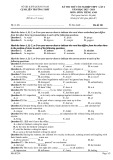
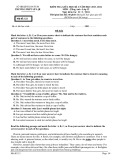
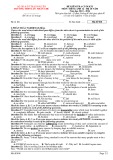


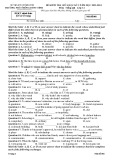
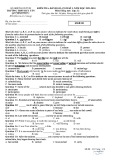
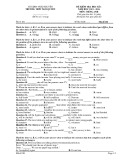


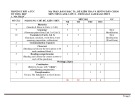
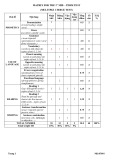
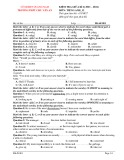
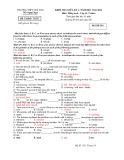
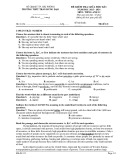

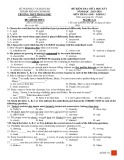
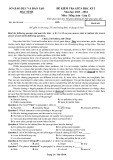
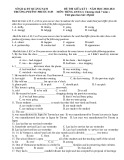
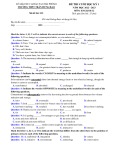

![Đề thi Tiếng Anh có đáp án [kèm lời giải chi tiết]](https://cdn.tailieu.vn/images/document/thumbnail/2025/20250810/duykpmg/135x160/64731754886819.jpg)
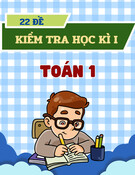
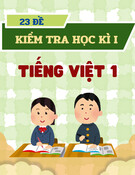
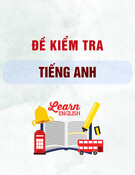

![Đề thi học kì 2 Vật lý lớp 11: Đề minh họa [Mới nhất]](https://cdn.tailieu.vn/images/document/thumbnail/2025/20250709/linhnhil/135x160/711752026408.jpg)
